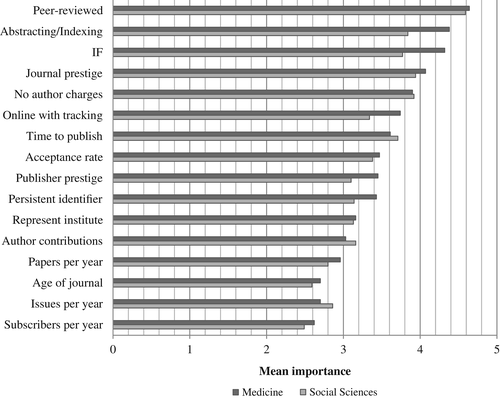
For most authors, the journal selection process is a challenge, and understandably so. There are about 42,500 peer-reviewed journals and 11,811 open-access journals,1 and this number is only growing with new journals, including predatory titles, being launched every year. For many, getting their research published is the ultimate goal, however, there is evidence to support the fact that a scientist’s standing within the research community is based on both the quantity and quality of his/her publications.2 That’s not all, authors also have to deal with the long wait times after submission and soaring rejection rates, which makes choosing the right journal crucial for publishing success. To make it easier for you, we’ve listed the most important points to keep in mind to simplify your journal selection for publication.
There are thousands of journals to choose from, Elsevier alone publishes about 2,500 active journals,3 so start your journal selection process by narrowing down your options. First, review the journals you read for your own research or do a literature search for articles with a similar scope and impact as yours and see where they’re published. Another tip for choosing the right journal is to tap your network of colleagues, advisors, and association members for recommendations and do an online search, using relevant keywords, to identify top journals in your field. Remember to also consider the significance of your work and the readership you are targeting to find a journal that matches your expectations.
Another important thing to know in the journal selection process is that journals can be very specific about their subject area, some focus only on a particular aspect within a larger field of study, so be sure to do a comprehensive review before starting the process of journal selection for publication. Browse official websites to learn more about the journal’s aims and scope, including restrictions on the type of articles accepted, before you decide to submit or you face almost certain rejection. Apart from choosing the right journal that can give you the best chance of acceptance, it is important to ensure your research is also easy to find and consume. Here, the journal’s visibility, audience, readership and impact are key considerations in your journal selection process. One way to do this is by checking if your target journal is indexed in subject-specific databanks, including electronic databases, and available online. Also find out how well known or read the journal is, and how well it compares with others who publish similar research.

*Source: Criteria for the journal selection process in an open access environment: A comparison between the medicine and social sciences, Wiley Online Library.
Once you complete the above checks, you will likely have eliminated unsuitable journals from your list. This is where you fine-tune your journal selection process by reviewing critical aspects such as the author guidelines, time taken for decisions and publication, publication charges, open-access options, the peer review process, and the acceptance and rejection rates. Following these key steps when choosing the right journal will help you shortlist at least three top matches for your research.
Expert tip: Some publishers allow manuscripts to be transferred between journals under its portfolio; so, considering journals that have this option might help you save time with resubmissions, reformatting, and, in some cases, even peer reviews.4
BONUS: Tips to identify predatory journals
In your journal selection process, you can identify unethical or deceptive behavior in journal publications by looking at a few important points. Evaluate the journal website and see if it has professional content, if the publishing process and fees are clearly mentioned, and if the full contact details (including address) are given. Bogus journals often take payments without ever publishing your work, while others will publish articles without any form of editorial or peer review checks. Additionally in your journal selection for publication, look up previous issues of the journal to check the quality of articles published, and ask your seniors if they are familiar with the journal or if it is a reputed journal in the field. Also check if the editorial board members are well known researchers and whether the journal is affiliated with professional bodies like Committee on Publication Ethics (COPE), the Directory of Open Access Journal (DOAJ), International Association of Scientific, Technical and Medical Publishers (STM), or Open Access Scholarly Publishers Association (OASPA). However, to ensure you’re choosing the right journal, it is advised not to take this at face value, especially if you have not heard of the journal before; instead double check these affiliations by browsing member listings on the organization’s site or contacting them directly. Another red flag on your journal selection process are journals that send out unsolicited emails asking individuals to submit articles with the promise of faster publishing or asking them to join the editorial team.
This guide on journal selection for publication is a collation of expert advice and essential checks to help you with choosing the right journal for your research, which can make all the difference between acceptance and desk rejection. It’s also important for researchers to be aware of other factors or even personal preferences that may influence their journal selection for publication. If you’re just getting started, and don’t know where to look, explore the Global Journal Database, which offers researchers all the relevant information to help you find the best-suited matches for your research. Part of the Researcher.Life ecosystem, this comprehensive database includes details on everything a specific journal has published to date making it your journal selection process easier. You can search by abstract, name or topics to find specific journals or upload your manuscript to get journal recommendations for your research work.
Even brilliant, high-impact work faces certain rejection if it doesn’t align with the journal’s aims and scope, which makes a well-thought out journal selection process your best bet. We hope these tips help you save time in choosing the right journal and the right home for your research manuscript.
References
- R. Johnson, The STM Report – An overview of scientific and scholarly publishing. Fifth edition, International Association of Scientific, Technical and Medical Publishers, 2018. Available online at
https://www.stm-assoc.org/2018_10_04_STM_Report_2018.pdf - T. Reller, Elsevier publishing – a look at the numbers, and more. Elsevier Connect, 2016. Retrieved from
https://www.elsevier.com/connect/elsevier-publishing-a-look-at-the-numbers-and-more - Journal selection and submission. Springer, as of July 2020. Retrieved from
https://www.springer.com/gp/authors-editors/authorandreviewertutorials/submitting-to-a-journal-and-peer-review/journal-selection-and-submission/10534960 - Journal selection and submission. Springer, as of July 2020. Retrieved from
https://www.springer.com/gp/authors-editors/authorandreviewertutorials/submitting-to-a-journal-and-peer-review/journal-selection-and-submission/10534960



